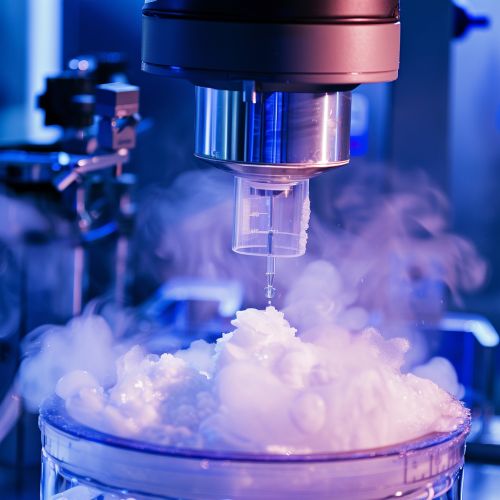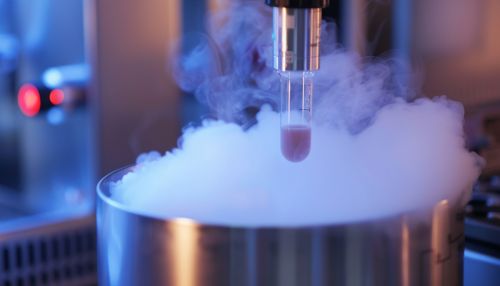Vitrification (cryobiology)
Introduction
Vitrification is a process used in cryobiology that involves the conversion of a substance into a glass-like solid that is free from any crystalline structure. This process is achieved by rapid cooling, which prevents the formation of ice crystals and allows the substance to reach a solid state without undergoing the usual phase transition from liquid to solid. Vitrification is a key technique in cryobiology, particularly in the preservation of biological samples at extremely low temperatures, known as cryopreservation.
History
The concept of vitrification in cryobiology was first proposed in the early 20th century, but it was not until the 1980s that the technique was successfully applied in a laboratory setting. The first successful vitrification of a biological sample was achieved by Gregory Fahy, a pioneer in the field of cryobiology, who demonstrated that it was possible to vitrify a small volume of rabbit brain tissue without causing significant damage.
Principles of Vitrification
Vitrification in cryobiology is based on the principle of rapid cooling. When a substance is cooled rapidly, the molecules do not have enough time to arrange themselves into a regular, crystalline structure. Instead, they become trapped in a disordered state, forming a glass-like solid. This process is facilitated by the use of cryoprotectants, substances that help to prevent ice crystal formation during the cooling process.
Cryoprotectants
Cryoprotectants are a crucial component in the vitrification process. These substances work by interacting with water molecules, preventing them from forming ice crystals during the cooling process. There are several types of cryoprotectants, including permeating and non-permeating cryoprotectants. Permeating cryoprotectants, such as glycerol and ethylene glycol, can penetrate cell membranes and protect the cells from the inside. Non-permeating cryoprotectants, such as sucrose and trehalose, cannot penetrate cell membranes and therefore only protect the cells from the outside.
Applications of Vitrification
Vitrification has a wide range of applications in cryobiology. One of the most significant applications is in the field of cryopreservation, where it is used to preserve a variety of biological samples, including cells, tissues, and organs. Vitrification is also used in the preservation of embryos and oocytes in assisted reproductive technology, and in the preservation of plant seeds and animal sperm for conservation purposes.
Cryopreservation
Cryopreservation is a process that involves preserving biological samples at extremely low temperatures, typically at the temperature of liquid nitrogen (-196°C). The goal of cryopreservation is to halt all biological activity, including the processes that can lead to cell death. Vitrification is a key technique in cryopreservation, as it allows for the preservation of biological samples without the damaging effects of ice crystal formation.
Assisted Reproductive Technology
In assisted reproductive technology, vitrification is used to preserve embryos and oocytes. This allows for the storage and later use of these reproductive cells, providing a valuable tool for individuals and couples undergoing fertility treatments. Vitrification has been shown to be a highly effective method for the preservation of embryos and oocytes, with survival rates often exceeding those achieved with traditional slow-freezing methods.
Conservation
Vitrification is also used in the field of conservation, where it is used to preserve plant seeds and animal sperm. This allows for the long-term storage of these biological materials, providing a valuable tool for conservation efforts. Vitrification is particularly useful in the preservation of endangered species, as it allows for the storage and later use of genetic material from these species.
Challenges and Future Directions
Despite its many applications, vitrification in cryobiology is not without its challenges. One of the main challenges is the potential for damage during the warming process, as rapid warming is required to prevent the formation of ice crystals. Future research in the field of cryobiology is likely to focus on improving the vitrification process, with the aim of reducing the potential for damage during warming and increasing the survival rates of vitrified samples.
See Also


